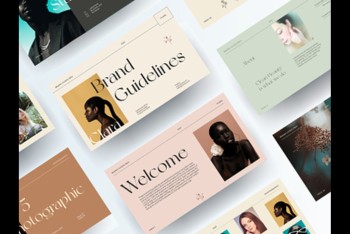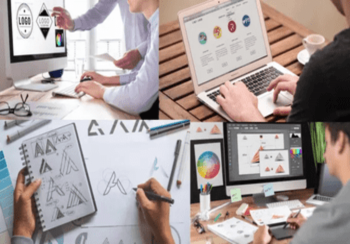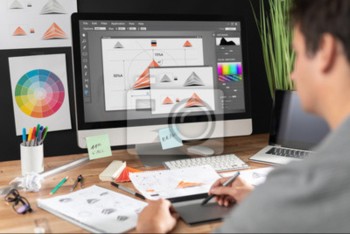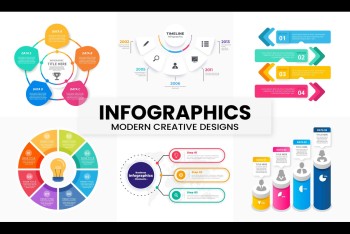The interaction between AI-generated logos and those created by human hands includes a range of methodologies and effects critical to understanding the differences between both design approaches. A brand's logo captures its essence and serves as the visual essential of recognition and identity. The incorporation of AI in logo design has completely transformed the process. This revolution is being driven by Artificial Intelligence, a domain that includes algorithms and systems that allow machines to mimic human intellectual capabilities. AI uses datasets and design aspects in logo design to produce logos independently. Logo Design Company in the USA provides logo designing services with AI and Human touch.
What is artificial intelligence (AI)?
Artificial intelligence is a collection of technologies and Algorithms that enable machines to learn human intelligence. In logo design, AI analyses large datasets and identifies patterns, styles, and design aspects to develop and generate logos.
Why Do AI-Generated Logos Need?
1. Efficiency: AI streamlines logo production, accommodating tight deadlines and changing design specifications. AI is better at efficiency than humans.
2. Cost-Effectiveness: Using AI in logo development saves human labor expenses, potentially providing a more cost-effective solution.
3. Diversity: AI-generated logos display various design choices derived from many learned patterns and styles.
4. Data-Driven Approach: AI learns and combines design components from large databases, resulting in a data-centric approach to logo generation.
Why Human-Created Logos?
1. Creativity and Originality: Human designers have creative ideas that bring life to a business's logo by boosting creativity and originality. Humans are more creative than AI tools.
2. Emotional Intelligence: humans have emotions and can include emotional intelligence into designs to make them more attractive and user-friendly.
3. Personalized Approach: Human designers work closely with clients to ensure the logo fully meets the brand's vision and objectives.
The Design Process for AI-Generated and Human-Created Logos:
1. AI-Generated: This method includes data analysis, pattern recognition, and automatic logo production based on previously learned design aspects.
2. Made by Humans: A collaborative and iterative approach that includes creative ideation, conceptualization, and client feedback at each level
Design Methodology
How AI and human-made Logos are Different from each other:
1. AI: AI relies on data-driven decision-making and pattern recognition but lacks human invention's creativity and emotional components.
2. Humans: To create meaningful and practical designs, prioritize creativity, emotional intelligence, and direct client engagement.
Design Resources
AI and human designers use the following tools in the logo creation process:
AI Tools:
AI uses specialized algorithms and design software trained on different datasets. The following are some regularly used tools:
1. Adobe Illustrator: This program evaluates and creates logos based on previously learned patterns and design aspects.
2. Canva: Used with AI algorithms to produce logos automatically, with various design alternatives.
3. Hatchful by Shopify: An AI-powered tool for businesses and entrepreneurs to create logos with various templates and design possibilities to meet multiple branding demands.
4. Lookmark Logo Maker: Uses artificial intelligence to build logos based on user inputs, allowing customization via an easy-to-use interface.
Human Design Tools:
Human designers create distinctive logos by combining diverse design software tools with their creativity, expertise, and emotional intelligence. These tools include:
1. Adobe Photoshop: A powerful tool that allows designers to modify photos, graphics, and text to create unique logo designs.
2. Affinity Designer: A vector graphic design tool used for its tremendous skills in developing elaborate and precise logo designs while providing designers with a smooth interface.
3. CorelDRAW: Many designers prefer CorelDRAW because of its unique vector illustration and layout tools, which enable complex and adaptable logo compositions.
4. Inkscape: An open-source vector graphics editor allows designers to create scalable and sophisticated logos while providing various drawing tools and design capabilities.
These technologies serve as the foundation for logo creation, assisting AI and human designers in fulfilling their creative goals while distinguishing their approaches and results.
Comparison of AI and Human Designers' Logos:
1. AI-Generated: Create logos with recognized and consistent patterns learned from previous experiences.
2. Human-Made: Provides diversified, creative, emotionally compelling logos that meet clients' expectations and brand identities.
Audience's Emotional Reaction to AI-Generated vs. Human-Created Logos:
1. AI: Artificial intelligence may need more emotional depth and storytelling components in human-created logos, thus resulting in a less profound connection with the audience.
2. Humans: Create designs that emotionally connect with the audience, triggering certain emotions and establishing a stronger brand-consumer relationship.
Customization & Personalization in AI-Generated and Human-Created Logos:
1. AI: Provides limited personalization based on learned patterns but lacks personalized touch and adaptability of handcrafted creations.
2. Humans: Customize designs to unique customer preferences and brand identities, creating a more personalized and adaptable final product.
Logo Design Company in the USA:
A Logo Design Company in the USA is the best place for technical innovation and human creativity. These companies revolutionize logo development by leveraging modern AI tools and the creative skills of human designers. They create logos that define brand identities and communicate powerfully with people by flawlessly mixing advanced technology with the expressive touch of human nature. These organizations are leaders in the field, combining the efficiency of AI-driven processes with the subtle creativity of human design to ensure that each logo tells a fascinating story while establishing strong relationships between brands and their customers.
Finally:
To summarize, incorporating AI into logo design provides efficiency and diversity, whereas human-made logos excel in creativity, emotional resonance, and customization. Businesses can get help from a Logo Design Company in the USA that provides the best logo design services by using AI techniques and human creativity together. Recognizing and comprehending these key differences is critical in determining the best technique for logo creation. By bringing together the strengths of AI and humans, designers can produce unique and versatile designs that fit a wide range of client needs while ensuring the logo represents the business cohesively and generates a profound emotional connection with its audience.








